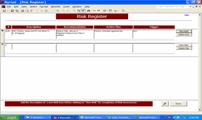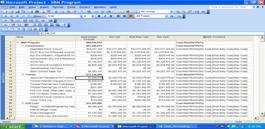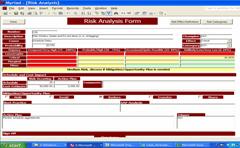Port of Seattle – Seaport Project Controls
POS – Project Controls
The Problem
Port of Seattle Seaport Project Managers routinely manage one or more projects simultaneously. The projects range from fairly small and straightforward to very large and complex. From time to time, critical issues arise that require specialized analysis and the application of advanced project management techniques. Often, there is intense scrutiny from customers and management and a need to provide information and make major decisions quickly with only limited time to develop and review options. There is an organizational imperative to provide advance notification of potential threats to project delivery and so anticipating issues and appropriately communicating about them is essential. Of course, the ultimate goal is to prevent threats to project delivery from occurring at all.
Complex challenges can and do occur at all stages of project delivery with more intense risk during project initiation and approval, during bid/award, in association with permitting efforts, and then potentially all during construction. Some of the most common and emergent project delivery challenges include the following.
- Issues that threaten the Project Schedule
- Issues that result in Construction Claims
- Issues that threaten the project Budget
- Issues that compromise the committed Scope
- Issues that require comprehensive and complex Communication
For this illustration the focus will be on 7 projects, each unique and yet manifesting one or more of these typical concerns. It is important to note though that any project within the Seaport Program could face a critical issue requiring special analysis at any time.
Shilshole Bay Marina Redevelopment — This project was an $80M major renovation of a busy marina facility and its associated uplands properties, including office space, restaurants, retail shops, and marina support facilities. The project was constructed through a GC/CM contract with complex contractual arrangements and multiple layers of participating subcontractors. The project scope was expansive with dock, building, and infrastructure elements overlapping and requiring considerable coordination. Complicating matters were ongoing marina operations which had to be sustained during construction. The budget for the project was limited and there was little margin for change. The internal customer and upper management were very involved and interested in the project, as were the public and marina customers. There was, therefore, a higher than normal need to communicate and report on the project. The broad reaching scope, the age and condition of the existing facilities, sustained ongoing operations, the breadth of new construction, an interruption in project manager assignment, and a dynamic contracting environment contributed to a project replete with challenges and requiring a steady stream of comprehensive and specialized project delivery support.
Fishermen’s Terminal Docks 5-10 — An issue arose with this $20M project upon bidding when the bids came in higher than anticipated. This prompted a comprehensive review of the scope, budget, and schedule to determine the appropriate approach going forward. In-water work limitations were a significant factor in schedule management and of course, cost was an important factor in reworking the scope. Like the Shilshole Bay Marina project, this project was occurring during on-going operations and there was significant sponsor, customer, and public interest.
Terminal 18 Upgrade — For this $50M terminal project the “critical” issues primarily involved construction schedule review with associated impact and claims analysis. The breadth of scope on this project, complex phasing, and a dynamic contracting environment posed significant delivery risks.
T-91 Utilities & Building Foundation — For this project there were significant critical issues involving the schedule, particularly as it impacted related program elements. Schedule and construction challenges also resulted in construction claims potential. This project was considered critical to the organization and was of particular interest to upper management.
T91 Carnitech Building — This project was part of a series of projects being completed within a tight time frame. Like the T-91 Utilities project, it was very visible and of critical interest to management. Business issues involving the lease and other “in the field” construction issues challenged the schedule and budget targets and elevated claims issues.
Terminal 5 Apron Extension — This project was (and remains) in the early stages of definition and planning. Significant consideration and analysis of scope, schedule, and budget issues was required to determine whether to proceed, and if so, on what basis. This required comprehensive risk evaluation regarding scope, schedule, and cost issues and a documented recommendation.
Terminal 30 Container Terminal Reactivation Project/T91 New Cruise Terminal — These projects include a series of projects to facilitate the relocation of the Terminal 30 cruise operations to a new facility at Terminal 91 and the work to combine Terminals 25, 28 and 30 into a 70 acre contiguous container terminal.
The T30 project will involve upgrade of the wharf to support 100 ft gauge container cranes, installation of a sheet pile cut-off wall and relieving platform along the bulkhead of the wharf, and significant improvements to the electrical features for crane power and cold ironing. Upland work elements will include demolition of a 90,900 sq. ft. building and foundation; construction of reinforced concrete runways for rubber tired gantry (RTG) cranes; steel platforms to access stacked reefer containers; a longshore lunchroom building remodel; gate processing area features including truck scales, communications pedestals, slabs for future OCR shelters, and miscellaneous prefabricated guard shacks and kiosks. Also included are reinforced concrete pavement slabs for equipment parking/fueling; storm drainage features; sanitary sewer piping and watermain modifications; electrical system upgrades to substations, site lighting improvements; and associated paving, striping and fencing.
The T91 project consists of construction of a 144,000 square foot, two-story cruise terminal building supported by spread footings. Significant consideration and analysis of scope, schedule, and budget issues was required to determine whether to proceed, and if so, on what basis. This required comprehensive risk evaluation regarding scope, schedule, and cost issues and a documented recommendation. The T30/T91 program has significant challanges that has to be manages and coordinated. The construction is occurring on sites with on-going operations and the budget and schedule is tight.
P&M was selected as the prime consultant for the T30/T91 Project Controls including cost & schedule management and comprehensive estimate evaluation, cost and scheduling risk analysis and establishing Program Budgets.
The Solution
| SBM | FT | T18 | T91i | T91c | T5 | T30/ T91 | ||
| • | Project Delivery Plan – provide guideline for how project controls & delivery occur | + | + | + | ||||
| • | Cost Controls – provide trend tracking, forecasting and budget analysis | + | + | + | + | |||
| • | Comprehensive Schedule Management – develop schedule, update, review & analyze, report | + | + | + | + | + | + | |
| • | Claims Analysis – evaluate schedule impacts, entitlements and cost impacts | + | + | + | + | + | + | |
| • | Risk Analysis – identify risk, estimate costs, evaluate impacts, recommend mitigation | + | + | + | + | |||
| • | Communicate – provide analysis and information via reports and presentations | + | + | + | + | + | + |
The solution in this case involved the Seaport Project Management and the Engineering/Construction Management Group utilizing the resources of the P&M (prime consultant) and it subconsultant CMG who were available through the Seaport Project Management Office. For each referenced project the exact response varied but involved the application of tools and techniques of advanced project management and project delivery support. These tools and techniques include some of the following and were deployed on the7 projects as indicated.
The solution in this case involved the Seaport Project Management and the Engineering/Construction Management Group utilizing the resources of the P&M (prime consultant) and it subconsultant CMG who were available through the Seaport Project Management Office. For each referenced project the exact response varied but involved the application of tools and techniques of advanced project management and project delivery support. These tools and techniques include some of the following and were deployed on the7 projects as indicated.
In each case, the solution was provided as a supplement to existing and on-going project management being performed by the assigned lead project manager. The consulting team used advanced analytical tools and methodologies to respond to critical concerns and provide needed information for better decision making. In most cases, the organization either did not have in-house capability to perform these additional functions or did not have available resources.
Support for schedule development was provided using the Port’s standard Microsoft Project and the seaport project schedule template (developed in part by the consultant team). Construction schedule analysis was performed using Primavera P3 / P6 and MS Project to compare and analyze changes over time and determine the impact of certain events and decisions on performance. Other analyses associated with the Critical Path Scheduling (CPM) methodology were used to evaluate options and identify “critical” tasks. Reports were produced to communicate information and facilitate decisions.
Support for budget and cost tracking was provided using the SPMG’s custom in-house SPOTS database (developed by the consultant team) with additional tracking and analysis supported through Myriad, a proprietary tool developed by P&M. Trends were identified and recorded, analyzed and tracked to develop and maintain a meaningful forecast and allow for appropriate reporting.
Risk Analysis, including claims and impact assessments, were done using a series of tools. The most comprehensive tool was Myriad which incorporates the subsidiary tools of @ Risk Project and Risk Amp. Myriad was used to track and monitor risks and subsequently analyze them using probabilistic methodologies. By combining cost and risk information, Monte Carlo probabilistic analysis can be generated to provide more accurate and reliable forecasts for complex and dynamic projects. The methodology also creates greater confidence and credibility for the manager and makes subsequent decisions more valid.

Excerpt from Myriad 
Excerpt from Myriad 
Excerpt from Myriad
Additional reporting and communications support was also provided. Special presentations and reports were needed to inform management and facilitate appropriate review and decision making. In the case of the Shilshole Bay Marina project, for example, comprehensive quarterly reports were required to demonstrate to upper management that the project delivery was on track and to highlight areas of risk or concern.
The Result

It is fair to say that even the most robust project controls and delivery support cannot overcome all possible perils. However, in each of the cases represented here, the application of advanced support services improved project delivery results. The most significant and fundamental improvement was in the application of Best Practices for Project Delivery and Project Controls. Using the tools and techniques of trend tracking, forecasting, schedule impact analysis, variance analysis, and risk management, the client had early and accurate warning of potential impacts to scope, budget, and schedule. Armed with this advanced warning, decisions were made that optimized the project delivery outcome by either mitigating realized risks or avoiding potential problems altogether. The management tools and techniques deployed by both the SPMG and the consultants also helped keep project elements and issues visible to stakeholders and decision makers. This instilled confidence and credibility and allowed critical decisions to be made more neutrally and on the basis of sound information. The client was generally able to take a more favorable position with respect to potential construction claims, was able to phase construction to meet critical schedule milestones, and was able to maximize scope while keeping within budget. The information and understanding made available by the tools allowed the client to manage project with greater flexibility and focus. It also allowed the Project Manager to work more effectively with the Construction Manager and the sponsoring business unit.
